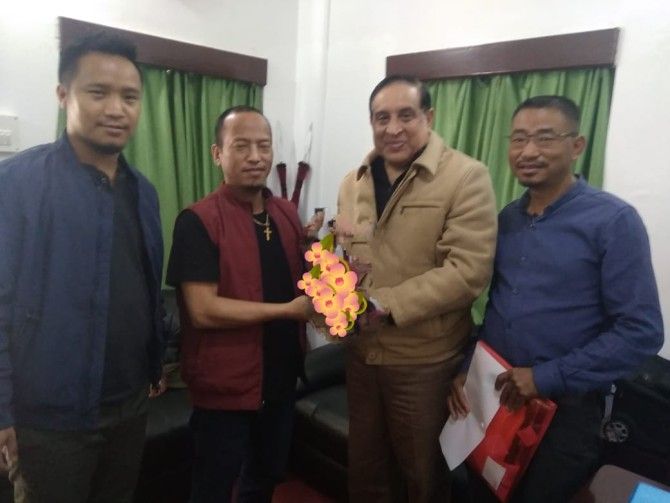The leadership of the NSCN-K is scheduled to join the peace negotiations in March as part of the Naga National Political Group with Government of India’s Interlocutor R N Ravi, reports Sujit Kumar Chakraborty.

After a gap of four years, the National Socialist Council of Nagaland-Khaplang faction has officially joined in the peace negotiations with the Government of India.
It attended the Ceasefire Supervisory Board meeting held on February 23 in Kohima, the capital of Nagaland.
The chairman of the CFSB, Lt Gen (retired) Shokin Chauhan chaired the meeting with a three-member delegation of the NSCN-K faction. They are general secretary Isak Sumi, deputyy defence kilonser (kilonser means minister) Shilem Konyak, and Newel, kilonser and supervisor of the CFSB group.
In March, the leadership of this group is scheduled to join the peace negotiations as part of the Naga National Political Group with Government of India’s Interlocutor R N Ravi.
Saturday’s CFSB meeting was mainly a familiarisation parade. However, the breakaway faction is believed to have told the chairman that they need at least two designated camps in Mon and Tizit region to house about 400-odd cadres and leaders of the group.
They are scheduled to place the list of names in the next meeting, for the issue of identity cards, scheduled for the end of this week.
It is reliably learnt that the new group would be allowed to set up one camp in Mon district of Nagaland for the time being. The chairman of CFSB is also scheduled to meet representatives of all other NSCN groups this week to discuss and ensure that ceasefire ground rules are honoured.
It is pertinent to note that NSCN-K group based in Myanmar signed a ceasefire agreement with the Government of India in 2001 and in March 2015 unilaterally abrogated the agreement.
On June 9, 2017, S S Khaplang, one of the top-ranking leaders of the Naga underground movement, breathed his last in his Myanmar headquarter. Subsequently, Indian origin Konyak Naga leader, Khango Konyak, was chosen as Khaplang’s successor.
However, within three months, Khaplang’s nephew, 45-year old Yung Aung, ousted Khango and took over the reins. Aung is a Heimei Naga and in the process the Indian-origin Naga leaders and his followers were given a safe passage to the Mon region of Nagaland state.
Significantly, the breakaway NSCN-K faction has formally joined the Naga National Political Group. This six-group combo constituted a working committee in December 2016 and, in September 2017, Government of India’s interlocutor R N Ravi invited the NNPG for its first meeting.
Since then they have attended over 50 meetings in different places and finally signed an agreement in November last year.
In the agreement the Government of India has “recognised the political and historical rights of the Nagas to self determine their future in consonance with their distinct identity” and both sides are believed to have agreed to work out a relationship that is “honourable, inclusive and enduring for peaceful co-existence.”
Now the entry of a new group in the NNPG will no doubt take some more time to work out the final peace agreement.
Delay in signing Naga peace accord
Although Nagas are mounting pressure on the Government of India for an early solution to the long-awaited peace talks, the process is expected to take a final shape after the formation of a new government at the Centre.
On February 23 the Nagas organised a Global Naga Mass Rally in the national capital demanding an early solution to the ongoing Indo-Naga peace talks. But it is unlikely to happen.
Naga interlocutor R N Ravi is scheduled to visit Nagaland on February 26 to interact with different Naga civil society organisations, besides students and youth of the state, to gauge the overall situation.
Said a senior NSCN leader on condition of anonymity, “Now the Government of India is in election mood. For any solution with Nagas, the Government of India has to convene Parliament and amend certain provisions of the Constitution to accommodate our demands. Also, any such step at this juncture might create unnecessary tension in Manipur, Arunachal Pradesh and Assam since a sizeable Naga population is inhabiting all three states.
“Another important aspect is that if the Modi government returns to power, we have to just continue the peace process. But if a new government takes over in Delhi, everything has to begin from zero. So Nagas are restless and confused today.”
Internal bickering
The internal bickering within NNPG and NSCN-IM has also come out into the open. NSCN-IM supremo Th Muivah, in an interview recently, blamed the NNPG combo for acting as a “parallel force” propped up by the Government of India against the NSCN-IM.
The NNPG took serious exception to Muivah’s comment and said, “Even after two decades of negotiations with the Government of India the narrative of Mr Muivah has not changed. We consulted wide sections of Naga society during our talks with the Government of India in past two years. We are sure that both the entities have understood each other’s position and have touched all aspects of the Indo-Naga conflict and worked on the redressal for enduring peaceful co-existence as two entities.
“The ongoing process is leading to its logical conclusion between NNPGs and Government of India and no one should try to fool and mislead the Naga people anymore.”
In fact, the entry of the Khango Konyak led NSCN-K faction to the NNPG combo has further enraged the NSCN-IM group. Initially, in October last year, the NSCN-IM leadership interacted with the Khango Konyak group and invited them to join the NSCN-IM. But after a series of interactions with the people in the Konyak region, the breakaway faction of NSCN-K decided to join the NNPG combo which is a combination of different Naga tribed of Nagaland.
The NSCN-IM is mainly dominated by the Tangkhul Naga tribe of Manipur and the Sema tribe of Dimapur, Nagaland.
The Konyak tribe is the most ferocious force and they constitute about 40 per cent in the rank and file. Naturally, the entry of Khango Konyak faction in the NNPG has provided an advantage to the Government of India while bargaining with the NSCN-IM Collective Leadership on few unresolved issues like the use of Naga flag, separate Naga constitution to establish Naga identity, and some of the nomenclatures in the final peace accord.
Now, it remains to be seen how the Government of India tackles all these aspects of the ongoing peace talks while working out a lasting peace accord.










